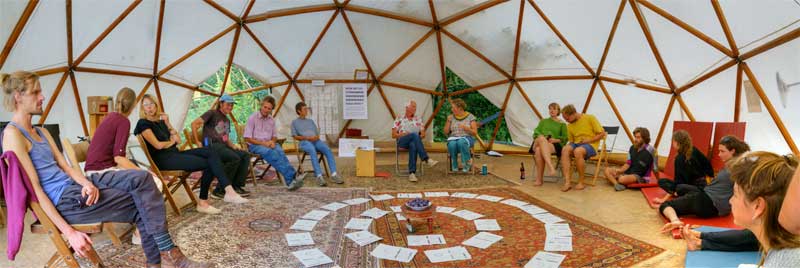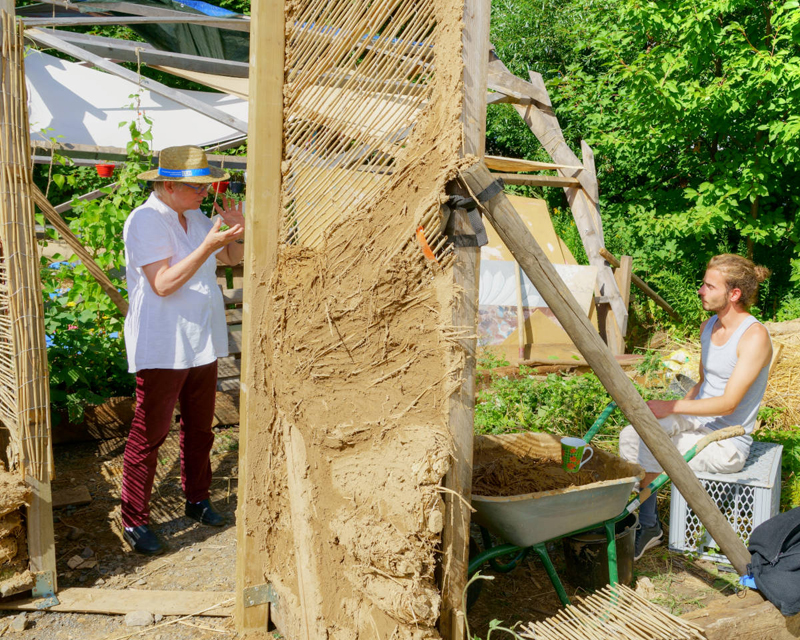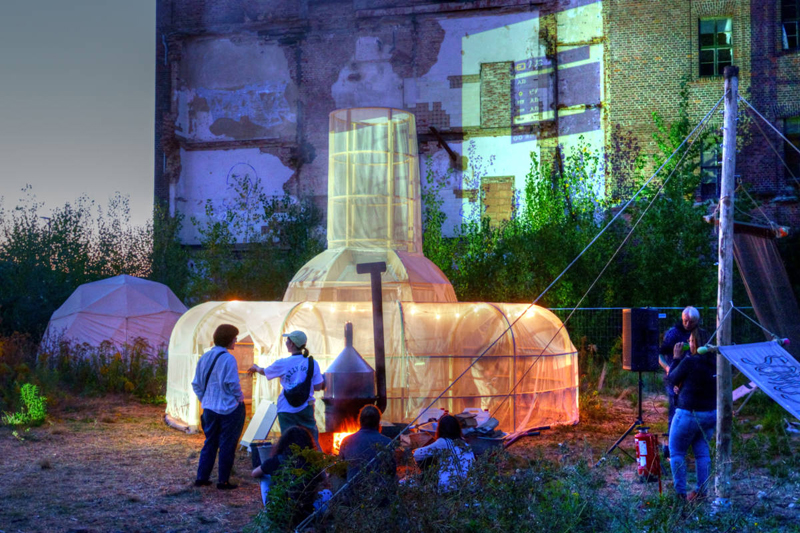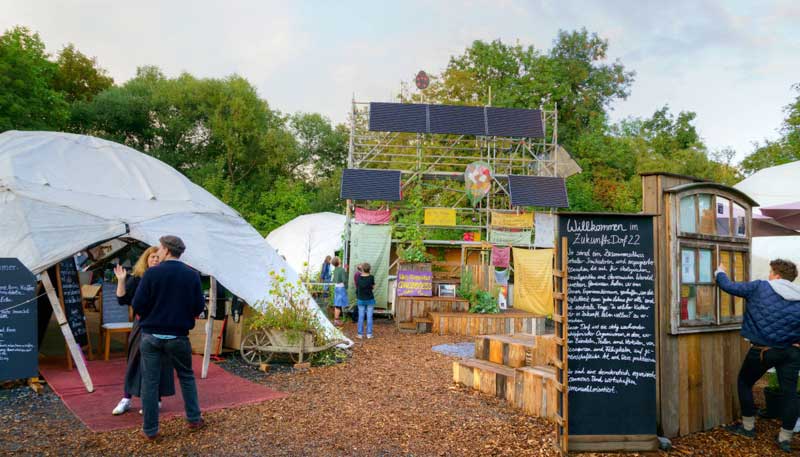by Dagmara Genda // Oct. 20, 2022
The ZukunftsDorf22 (Zkd22), or Village of the Future, was a Kassel-based initiative concomitant to, but not officially part of documenta fifteen. It was a partnership intended to root this year’s event into the ecosystem of the city so as to build local connections that could be sustained after the end of the event. The Zkd22 was a collaboration between many socially engaged initiatives, such as Architects for Future (a national network of architects working for sustainable construction standards and planning) and FoodsharingKS (an initiative that organises the distribution of still edible food from supermarkets to counter waste and overproduction), as well as any individuals who wanted to experiment with sustainable and inclusive social models together. They did so by erecting a village from scratch. This village functioned as a living, workshop, education and cultural space over the 100 days of documenta. Though gone now, it has built a network that plans to continue what was started in the village this summer.

Zukunftsdorf22: Installation view during documenta fifteen, 2022 // Photos by Reiner Pietrzak und Karsten Piorr
Many projects such as this were obscured by the charges of antisemitism lobbed against the organisers and curatorial team of documenta. The effect was that little attention was devoted to how the show impacted the local community. This was, after all, one of the main goals of ruangrupa—to reach into parts of the city traditionally untouched by the quinquennial and involve local initiatives. The national and international discussions thus served to keep the many local voices unheard and perhaps even helped to delegitimize them. In painting localities with the brush of provincialism, an honest, though admittedly difficult, engagement with difference and place was hindered. Balanced critique in regards to ruangrupa’s own lack of context or considered curation, for example, was instead instrumentalised by national political interests, the intricacies of which have been dealt with elsewhere, such as by Hito Steyerl in Zeit Online, and touched upon by Jörg Heiser in Art-Agenda. We took the time to talk to Beat Sandkühler, one of the founders of the Zkd22, to report on how one of the most controversial documentas might be remembered by more than the charges of antisemitism that plagued it.
Dagmara Genda: What is your role in the Zkd22?
Beat Sandkühler: I joined the planning group for the Zkd22 in late 2021 along with ‘eigenklang,’ an international performance collective of which I am a part. Later I was primarily involved in public programming, design, online presence and event planning. Since the end of 2021 I was also closely communicating with Reza from ruangrupa to make the village and its program a reality. My collective and I initiated many events ourselves—‘Theme Days: Exile,’‘Participation Wednesdays,’ Concerts by inclusive bands, performances, etc. I also maintained contact between the Artist Home and Zkd22.

Zukunftsdorf22: Sustainable building workshop, 2022 // Photos by Reiner Pietrzak und Karsten Piorr
DG: How did the idea for Zkd22 form and would it have happened without documenta?
BS: The idea came from the Gemeinwohl-Ökonomie-Gruppe (Economy for the Common Good) Kassel. It was inspired from the concept of Lumbung, the communal rice barn, with the goal of building a place for encounter and exchange in Kassel. There are many projects and initiatives in Kassel whose aim is to build a better future for all. Unfortunately what we lack are contacts and connections with one another, which is something that the Zkd22 served to remedy. Without documenta, this would have never happened.
DG: What advantages did you gain from working within the framework of documenta fifteen?
BS: documenta sowed the seeds for the conception of the village, and with its inclusion in the 100-day program, provided us with more visibility and contacts. We formed many ties to other Lumbung collectives and together, we organised a number of events such as jam sessions with Jatiwangi art Factory, a party with Más Arte Más Acción and many diverse events with our neighbours Serigrafistas queer from Argentina. We held a weekly program called ‘Cosmo-Local Conversations,’ in which we invited various Lumbung Collectives to explore parallel interests and themes in our respective practices as well as what was taking shape in the village. Conversely, collectives from the Zkd22 were invited to the discussions held by other collectives, where many overlaps between our methods were discovered.

Takashi Kuribayashi: ‘Genki-Ro,! 2021, Japanese herbal steam sauna in the shape of the nuclear reactor from Fukushima installed in the Zukunftsdorf22 // Photos by Reiner Pietrzak und Karsten Piorr
DG: Can you describe what a typical day in the village looked like?
BS: There really was no typical day. Each day was filled with different events, topics and a new, interested public. In total we had an estimated 500 different events.
Bordering the village we had built an Artist Home where about 15-20 people, including myself, lived over the 100 days. We were the inhabitants and caretakers of the village. Many guests who came from outside of Kassel were hosted in the Artist Home. Our daily chores included crew and space care, watering plants, event management and support.
DG: Will the Village keep functioning after documenta?
BS: The Zkd22 has already been taken down, because we have to give the property back to its owner. Thus the village has no permanent home but we have developed a stable network. We are now on the lookout for a permanent space in Kassel. It was incredibly important to have the space for the time we did. We strengthened our networks and got to implement that which we could only discuss in theory before.
DG: Documenta has been plagued by many controversies, most notably the debates about antisemitism. Were you affected by this on-going situation?
BS: We also felt the consequences of the antisemitism debates in the framework of documenta, even when we were not affected by them. We could still hold all our events and implement our program as planned.
DG: You pose a few questions in regards to the Zkd22 on your website. For example, „What do we need for a permanent local ‘Transformation Network?’ Have you come closer to answer this?

Zukunftsdorf22: Installation view during documenta fifteen, 2022 // Photos by Reiner Pietrzak und Karsten Piorr
BS: After 100 days I think we are a step closer to an answer. Through collaborative work in a collectively designed space, we have been able to get to know those working toward societal transformation and we have been able to network. We have exchanged experiences, stories and commonalities that will hopefully enable us better work toward our vision, a “Gutes Leben für Alle” (a good life for everyone).
DG: What role do you think art can play in this process?
BS: I think that art can encourage the transformation process and in part, to initiate it. Art can also help design the process and, through an exhibition format, give it life and make it develop faster. The Zkd22 has showed me how art can unleash energy and bring people, who also want to transform the way we live together.



















